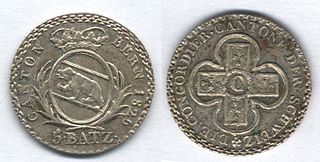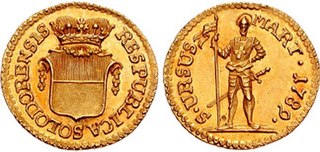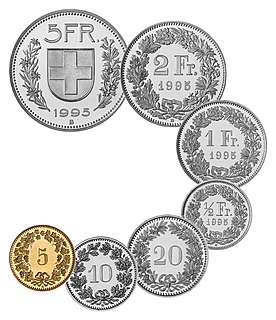
The Frank was the currency of the Swiss canton of Aargau between 1798 and 1850. It was subdivided into 10 Batzen, each of 4 Kreuzer or 10 Rappen.
The Frank was the currency of the Swiss canton of Appenzell Ausserrhoden between 1798 and 1850. It was subdivided into 10 Batzen, each of 4 Kreuzer or 16 Pfenning.
The Basel frank was the currency of the Swiss canton of Basel between 1798 and 1850.

The Thaler was the currency of the Swiss canton of Bern until 1798. It was subdivided into 40 Batzen, each of 4 Kreuzer. It was replaced by the Frank of the Helvetian Republic in 1798. This was, in turn, replaced by the Berne Frank in the canton of Bern, and by the Vaud franc in the canton of Vaud.

The Frank was the currency of the Swiss canton of Berne between 1798 and 1850. It was subdivided into 10 Batzen, each of 10 Rappen.
The Gulden was the currency of the Swiss canton of Fribourg until 1798. It was subdivided into 14 Batzen, each of 4 Kreuzer or 16 Denier. It was replaced by the Frank of the Helvetian Republic in 1798. This was, in turn, replaced by the Fribourg Frank.
The Frank was the currency of the Swiss canton of Fribourg between 1798 and 1850. It was subdivided into 10 Batzen, each of 4 Kreuzer or 10 Rappen.
The Frank was the currency of the Swiss canton of Glarus between 1798 and 1850. It was subdivided into 100 Rappen, with the Schilling worth 3 Rappen.

The Frank was the currency of the Swiss canton of Luzern between 1798 and 1850. It was subdivided into 10 Batzen, each of 10 Rappen or 20 Angster.
The Frank was the currency of the Swiss canton of St. Gallen between 1798 and 1850. It was subdivided into 10 Batzen, each of 4 Kreuzer or 16 Pfennig.
The Frank was the currency of the Swiss canton of Schaffhausen between 1798 and 1850. It was subdivided into 10 Batzen, each of 4 Kreuzer.
The Frank was the currency of the Swiss canton of Schwyz between 1798 and 1850. It was subdivided into 10 Batzen, each of 10 Rappen or 20 Angster.

The Thaler was the currency of the Swiss canton of Solothurn until 1798. It was subdivided into 40 Batzen, each of 4 Kreuzer or 8 Vierer. It was replaced by the Frank of the Helvetian Republic in 1798. This was, in turn, replaced by the Solothurn Frank.
The Frank was the currency of the Swiss canton of Solothurn between 1798 and 1850. It was subdivided into 10 Batzen, each of 4 Kreuzer or 10 Rappen.
The Frank was the currency of the Swiss canton of Thurgau between 1798 and 1803. It was subdivided into 10 Batzen, each of 4 Kreuzer.

The Ticinese franco was the currency of the Swiss canton of Ticino between 1813 and 1850. It was subdivided into 20 soldi, each of 12 denari, similar to the British pounds, shillings and pence system.
The Frank was the currency of the Swiss canton of Unterwalden between 1798 and 1850. It was subdivided into 10 Batzen.
The Frank was the currency of the Swiss canton of Uri between 1798 and 1850. It was subdivided into 10 Batzen, each of 10 Rappen.

The franc was the currency of the Swiss canton of Vaud between 1798 and 1850. It was subdivided into 10 batz, each of 10 rappes. The usual price unit was the Batz.

The Frank was the currency of the Swiss canton of Zürich between 1798 and 1850. It was subdivided into 10 Batzen, each of 10 Rappen, with 3 Heller to the Rappen and 4 Rappen to the Schilling.










